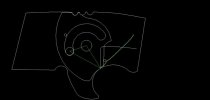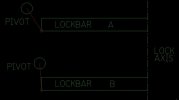- Joined
- Mar 5, 2012
- Messages
- 151
Hay Guys,
I have made about 100 folders now, and now that they have been around a couple years every once in a while Ill get one back for repair or its just worn out a bit. I have been working on new designs and trying to make the existing designs better. I hope some one can give me some help on this to make my lockup design a little better.
I have had 2 flippers come back that had a little bit of vertical blade play when open. I am 100% certain it is not lock rock. so lets not get into that. it seems with the internal stop pin set up Im using causes any slight play in the pivot, translates right to the blade instead of being absorbed into the lock by camming action. so if the pivot hole is .250 and the pivot is .249 I get that .001 transferred all the way down the blade to the tip 4" later and it ends up being several thousandths.
I have Bob Ts book and know about lockup geometry for the most part. I still have much to learn.
Here is a simple drawing of how my lock is now.


The green triangle in the open position should give you a reference as to where the camming action is taking place. it seems that I cant get the lockface of the frame below the center line of the stop pin to create enough camming action to take up and slack in the system. So basically there is not a lot of forgiveness to this setup currently.
Here is what I just drew up in hopes of moving the triangle to better account for inconsistency and have more forgiveness.


I didnt have to do much but rotate the whole stop pin track a bit and adjust the blade shape to suit.
Any body have any other recommendations? besides switching to a external stop pin as I rather like the ease of making an internal compared to an external.
I have WJ waiting on new drawings.
Thanks guys! God bless
I have made about 100 folders now, and now that they have been around a couple years every once in a while Ill get one back for repair or its just worn out a bit. I have been working on new designs and trying to make the existing designs better. I hope some one can give me some help on this to make my lockup design a little better.
I have had 2 flippers come back that had a little bit of vertical blade play when open. I am 100% certain it is not lock rock. so lets not get into that. it seems with the internal stop pin set up Im using causes any slight play in the pivot, translates right to the blade instead of being absorbed into the lock by camming action. so if the pivot hole is .250 and the pivot is .249 I get that .001 transferred all the way down the blade to the tip 4" later and it ends up being several thousandths.
I have Bob Ts book and know about lockup geometry for the most part. I still have much to learn.
Here is a simple drawing of how my lock is now.


The green triangle in the open position should give you a reference as to where the camming action is taking place. it seems that I cant get the lockface of the frame below the center line of the stop pin to create enough camming action to take up and slack in the system. So basically there is not a lot of forgiveness to this setup currently.
Here is what I just drew up in hopes of moving the triangle to better account for inconsistency and have more forgiveness.


I didnt have to do much but rotate the whole stop pin track a bit and adjust the blade shape to suit.
Any body have any other recommendations? besides switching to a external stop pin as I rather like the ease of making an internal compared to an external.
I have WJ waiting on new drawings.
Thanks guys! God bless



